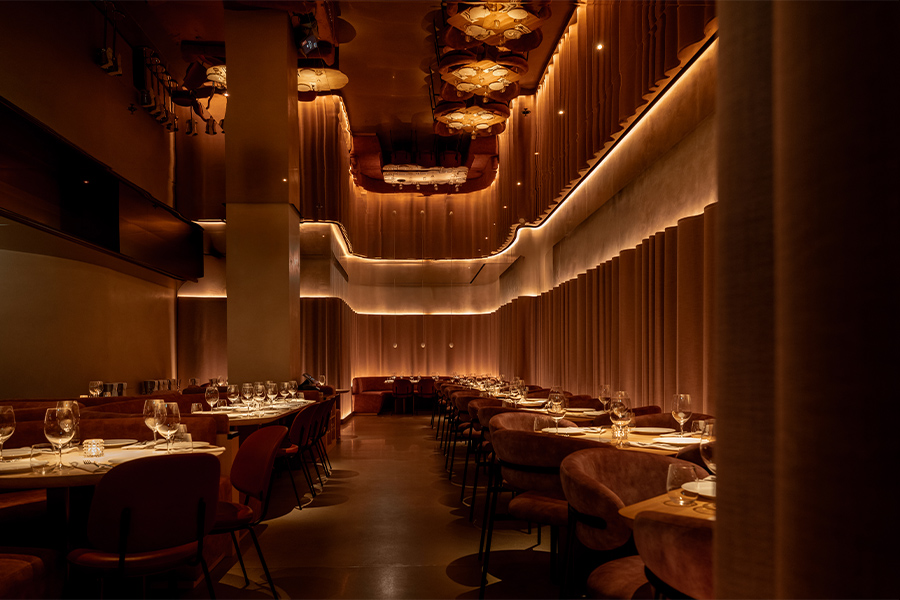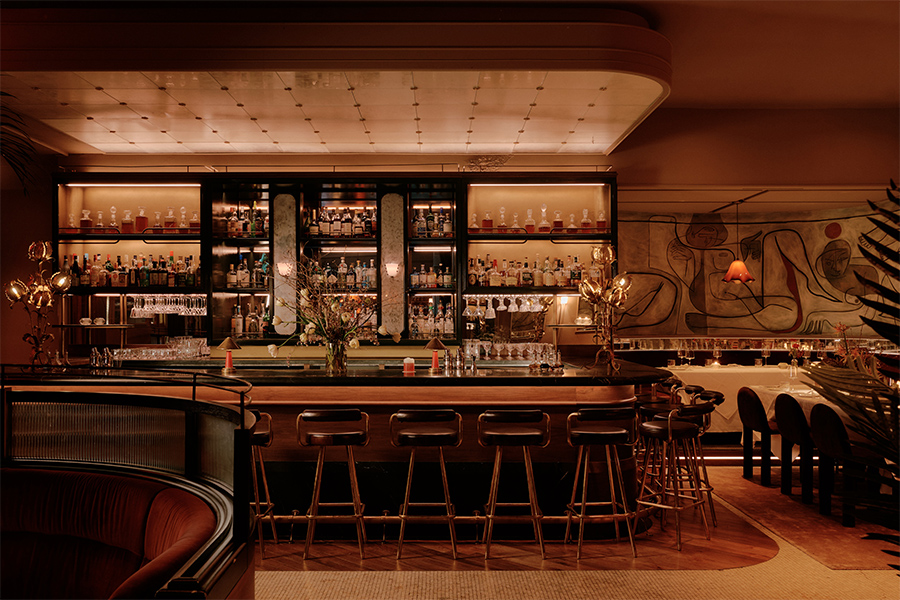Even in its stripped-down form—black steel, unpolished concrete, fragments of brick—the 1960s modernist building now housing Le Pristine on its ground floor possessed a sacred air, says Signe Bindslev Henriksen, cofounder of design studio Space Copenhagen. “It had proportions like a church, and the surfaces were incredibly beautiful even though we hadn’t done anything to them.”
Intrigued by this spiritual nature and the “brutality of the place as it appeared without anything in it,” says partner Peter Bundgaard Rützou, the duo preserved some of these raw elements inside the new Antwerp, Belgium restaurant from celebrated chef Sergio Herman, in partnership with Verso. The Belgian luxury fashion brand is located next door in a 17th-century Baroque mansion and can be viewed from one courtyard (a second courtyard is notable for its soaring 33-foot-tall tree) establishing a dialogue between food and fashion while also acknowledging “the juxtaposition between two different time periods,” says Bundgaard Rützou.

Chef Sergio Herman stands in front of Le Pristine’s theatrical open kitchen
At Le Pristine, Herman, who spent 25 years cooking at his family’s now-shuttered three-Michelin-star Oud Sluis in the Netherlands before launching several different restaurants, melds Italian flavors with the terroir of the seaside in his native Zeeland, bordering Belgium. “I wanted Le Pristine to be like a party—[where guests] eat well in a nice ambiance with good energy,” he says. Herman enlisted Space Copenhagen to animate that vision based on the firm’s previous work for Geist and the old Noma in Copenhagen. The trio immediately established an easy rapport. “You need to find a great connection to create something magical,” explains Herman. “It was a fantastic moment to see their first drawing.”
The long, 4,790-square-foot space, which Space Copenhagen crafted along with local firm Verhamme + De Vel Architects, is a layered manifestation of Herman’s dream. A showcase for smoked oak and the wood-fired oven, the café leads to the dining room, bringing the Antwerp chairs that Space Copenhagen designed specifically for Le Pristine together with muted green banquettes.
A moody palette of sand, gray, black, and rust conjures the paintings of Flemish and Dutch masters. Noting “a certain humbleness” that was part of Herman and Verso’s mission, Space Copenhagen was drawn to the works of Renaissance-era artists like Johannes Vermeer, who “painted everyday narratives,” says Bundgaard Rützou. “We were inspired by a compilation of those historic references.” Bluestone flooring, ceramics, and wallcoverings crafted from Belgian linen reinforce that “materials are very much anchored in the area,” adds Bindslev Henriksen.

Ceramics and linen wallcoverings showcase Belgian craftsmanship throughout the interiors
Numerous Belgian and Dutch artists and craftspeople aided that mindful process, stitching the project together organically. “It felt like we were laying out a puzzle and they were filling in the holes. It became a patchwork—a collage more than anything else,” says Bindslev Henriksen.
For example, the striking reception desk, designed by Maarten Baas and Bertjan Pot, exhibits an innovative light and clay technique, and the translucent pink resin bar from Sabine Marcelis is further brightened by her glowing orb installation. That piece complements Frederik Molenschot’s vivid blue sculptural depiction of Parmesan cheese wheels, a customized trifecta of Rotganzen’s melted disco balls, and a charcoal-on-canvas illustration by Rinus van de Velde capturing the hum of restaurant life above the open kitchen. “This restaurant is for Antwerp,” Bundgaard Rützou says. “We had to turn the fabric of this city inside out.”
This article originally appeared in HD’s February/March 2021 issue.
More from HD:
10 Pink Spaces That Pack a Powerful Punch
What I’ve Learned Podcast: Larry Traxler
3 Hotels Showcase the Power of Secondary U.S. Cities



